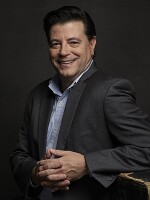September is Sickle Cell Disease Awareness Month. The rare, genetic blood disorder affects roughly 100,000 people in the U.S., according to the Sickle Cell Disease Association of America.
Haitian-American artist Hertz Nazaire has dedicated much of his creative output to his own struggles with sickle cell disease.
The first thing you notice when you walk into Hertz Nazaire's Bridgeport studio is the enormous, intensely colored paintings leaning up against nearly every inch of wall space, and laying on the floor.
His paintings are reminiscent of Africa and African art, a style Nazaire said hearkens back to his early life in Haiti.
"Most of what I keep about Haiti is the color," Nazaire said. "What I was influenced by as a kid was these little trucks called tap-taps. They're really colorful, they have murals painted on them. Usually they are a religious theme."
Nazaire came to the U.S. when he was eight years old. His childhood was marked by long periods of poor health, and regular trips to Bridgeport Hospital's emergency room with painful attacks called sickle cell crisis.
Art became his way of coping.
"I was not able to go outside, and play like the other kids, and run around in the sun, and do those types of things," he said. "So it made me think about art more because art is like such a personal thing. Sickle cell drew me to art because it is so peaceful."
His talent was nurtured in high school, and later at the Art Institute of Fort Lauderdale.
Nazaire was happily living a "starving artist lifestyle," often skipping meals to pay for art supplies. But in his early 20s, he suffered a major setback.
"There was a time in my life where I went blind for two weeks, and I still can't see out of my right eye," he said. It was a blood clot caused by sickle cell disease. The blood disorder attacks healthy, round, red blood cells, causing them to change into a crescent or sickle shape.
The abnormal shape sometimes causes the cells to get clogged in arteries, causing intense pain, strokes, and a host of other medical issues.
After temporarily losing his sight, Nazaire quit painting for three years, focusing instead on poetry. When he returned to painting, his impairment forced a major change in his style.
"There was a time I could look at a person's face and recreate the lines, the shadows, every detail," Nazaire said. "But I had to get to a place where I was okay with going more abstract. It was out of necessity just to experiment and try to say what you want to say in different ways."
And after losing much of his sight, Nazaire wanted to talk about sickle cell in his art.
He found that his new abstract style helped him depict on canvas the experience of living with sickle cell disease. His series of paintings depicting the unbearable pain of sickle cell crisis has received worldwide attention, including a recent showing at pharmaceutical giant Pfizer's New York headquarters.
Lately, Nazaire has been drawing and painting on enlarged reprints of photographs from his personal collection. One of them is a giant photograph of Hertz as a little boy, snugly tucked into his hospital bed, his mother standing over him, adjusting his hospital wristband. Behind her, Hertz drew tightly-wound swirls of color.

Nazaire's mother died in a car crash when he was 13. "In the back of the painting is all of these swirls," he said. "It's like the storm behind her, she shielding me from that -- so it's just like she shielded me, she took away half of my pain just by being there."
The worldwide life expectancy for someone with sickle cell disease is 40 to 60 years old.
Nazaire turns 43 next week.
He receives weekly blood transfusions, and he hasn't had a sickle cell crisis in eight years. Nazaire calls himself a "sickle cell warrior," someone who fights his own personal battle with the disease every day.
"There's so many different ways to die from this," he said. "Every time you go to the hospital, it's a war for your life. That's why the term stuck, because everyone feels like it's a badge of honor just to still be standing."








